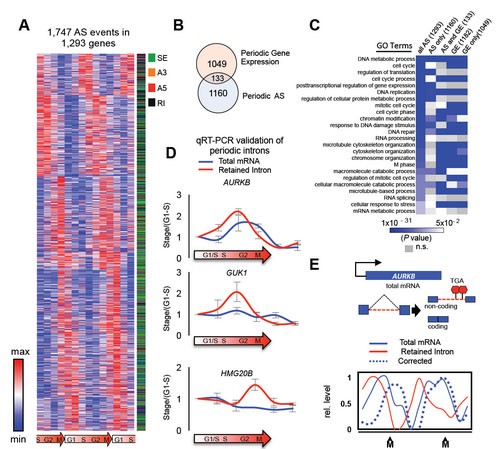
On March 25th, the international academic journal Elife published the latest paper "An extensive program of periodic alternative splicing linked to cell cycle progression" by Wang Zefeng, research group of the Institute of Computational Biology, Shanghai Institutes for Biological Sciences, Chinese Academy of Sciences. For the first time, this work discovered the temporal regulation of alternative splicing of RNA, and explained the regulation of the cyclical fluctuation of RNA splicing in cell cycle to cell division and proliferation. The mechanism of action of SR protein kinase CLK1 in these periodic alternative splicings is further revealed in the mechanism.
Alternative splicing is important for the diversity of protein expression: more than 90% of human genes can produce different functional protein subtypes through alternative splicing. In organisms, alternative splicing is strictly regulated, and the same gene is often expressed as different splice subtypes in different tissue cells or in different developmental stages of the same tissue. The abnormal regulation of splicing is closely related to many diseases such as cancer.
In previous reports, the cell cycle was coordinated by regulating the cyclical expression of specific genes. This study is the first to discover the cyclical fluctuations in RNA splicing that are ubiquitous in the human genome, and this cyclical splicing regulation is also an important control mechanism of the cell cycle. The researchers performed deep sequencing and analysis of two consecutive cell cycle transcriptomes by RNA sequencing, and found that about 1300 genes have variable splicing changes in the cell cycle. Most of these genes do not have cyclical changes at the transcriptional level, suggesting that periodic alternative splicing is another new mechanism that regulates the cell cycle independent of periodic transcription.
The researchers also found that most of the alternative splicing events in these periodically alternative splicing genes are regulated by the SR protein kinase CLK1; and that the expression level of CLK1 itself is regulated by the self-inhibition loop during the cell cycle. The periodic phase changes periodically and changes periodically. Further intervention in the expression level of CLK1 indicated that the decrease of CLK1 expression level directly leads to cell cycle disorder and inhibits cell proliferation. On the contrary, the increase of CLK1 expression level is closely related to the occurrence of various cancers, and the inhibition of CLK1 activity can be restricted. A variety of cancer cells grow.
This study reveals in detail the molecular mechanism by which CLK1 regulates alternative splicing of the cell cycle, and for the first time proposes that alternative splicing may be another regulatory mechanism for cancer development. The research work was completed under the guidance of researcher Wang Zefeng and was supported by the National Natural Science Foundation of China and the National Institutes of Health.

Detection of cell cycle-dependent alternative splicing
Seeding Machine,Seed Drill,Seed Planter,Drum Seeder
Taizhou Yingtian Agricultural Machinery Manufacturing Co., Ltd. , https://www.sakuradaagc.com